Menus
- Magni cum laude
- The resemblance to the original is striking at first glance
- Contemporary engines in their own chassis
- Who sits like Ago also feels like Ago
- Magni died on December 2, 2015 at the age of 90
- Arturo Magni – a legend
- Technical data – Magni-MV Agusta Filo Rosso
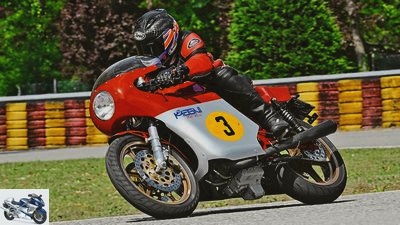
Kel Edge
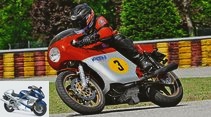
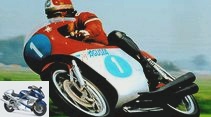
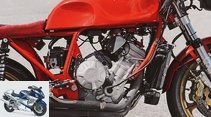
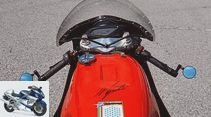
14th photos
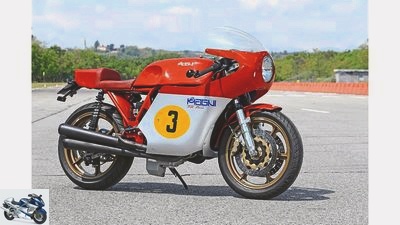
Kel Edge
1/14
The first look is deceptive. The machine is not a restored racer by Giacomo Agostini. With the Filo Rosso, refiner Magni is thinking back.

Kel Edge
2/14
An MV Agusta three-cylinder in a Magni chassis. Like 40 years ago.
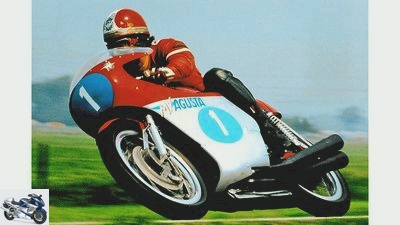
Kel Edge
3/14
Close. The visual proximity of the Filo Rosso to the factory racers of MV Agusta (Giacomo Agostini at the GP in Assen – 1970) is striking.
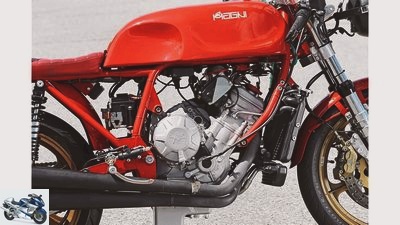
Kel Edge
4/14
Back to the roots: MV Agusta once achieved world fame with a three-cylinder. The 800 triplet should build on this history.
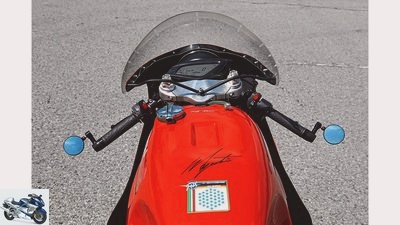
Kel Edge
5/14
The pressure cell for the shift assistant and the digital display were still unknown at the time.
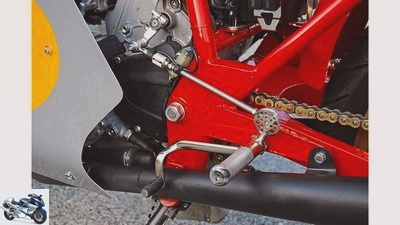
Kel Edge
6/14
Classic meets modern: the filigree perforated plate at the deflection of the shift linkage is reminiscent of the factory MV.
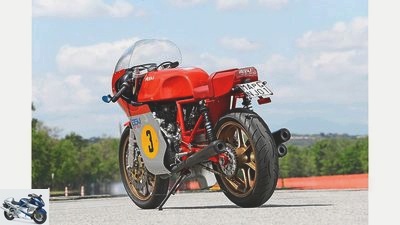
Kel Edge
7/14
Classic meets modern, the second: The three megaphones characterized the MV. The factory machines mostly carried the double tube on the left.
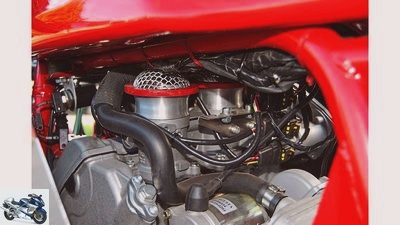
Kel Edge
8/14
The tank forces intake funnels to be open …
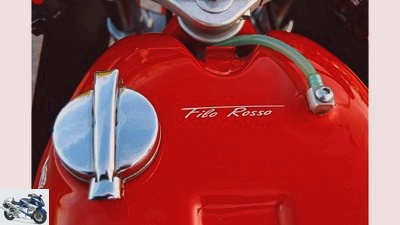
Kel Edge
9/14
… but apologizes with a classic look and finely drawn lettering.
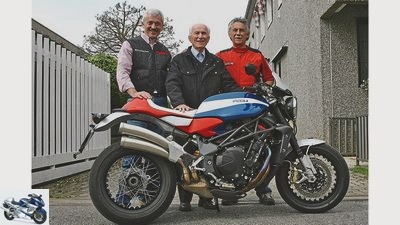
Kel Edge
10/14
Carrying the torch on: Carlo (right) and Giovanni Magni with their father Arturo behind the Storia.
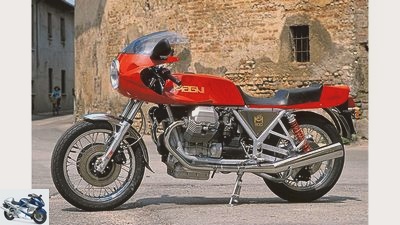
Kel Edge
11/14
Cult: The Le Mans with 1000 Guzzi engine and parallelogram swing arm made Magni popular as a tuner.
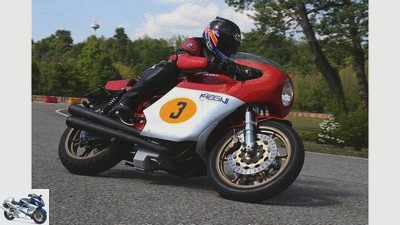
Kel Edge
12/14
Magni-MV Agusta Filo Rosso.
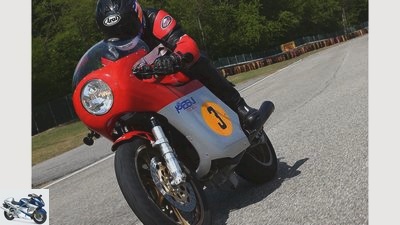
Kel Edge
13/14
Magni-MV Agusta Filo Rosso.
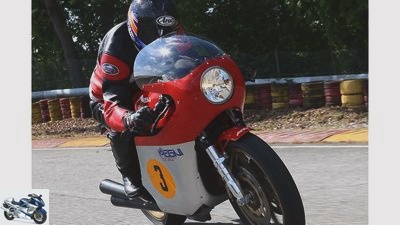
Kel Edge
14/14
Magni-MV Agusta Filo Rosso.
Magni-MV Agusta Filo Rosso in the driving report
Magni cum laude
The first look is deceptive. The machine is not a restored racer by Giacomo Agostini. With the MV Agusta Filo Rosso, the refiner Magni is thinking back: an MV Agusta three-cylinder in a Magni chassis. Like 40 years ago. A project that praises itself with great praise. Magna cum laude.
HToday Giovanni Magni can speak comparatively unmoved on this subject. In the summer of 2014, the emotional world of Arturo Magni’s son must have been much more turbulent. Because the allegations of the fan base weighed heavily. The Storia, at that time the latest project of the noble smiths from Samarate near Milan, was, according to the critics, not worthy of the name Magni.
Buy complete article
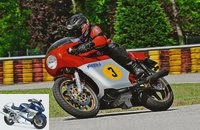
Magni-MV Agusta Filo Rosso in the driving report
Magni cum laude
Filo Rosso – the red line
A faux pas that – in retrospect – also had its good points. “After this experience, I wanted to show what Magni is capable of. We wanted to design a motorcycle that ties in with the origins of our company, ”says the irritable man, summarizing his motivation. In fact, Giovanni and his older brother Carlo turned the wheel of history back a long way. Because before the Magni company was founded in 1977, his father Arturo had already become a living legend as race director at MV Agusta.
Under his aegis, Giacomo Agostini won 13 world titles – all on the legendary three-cylinder engines from Varese. The new project should span the historical arc from Ago’s successes to Arturo’s life’s work as MV race director to the renowned refiner. The name: Filo Rosso – the red line. A symbolic designation of how far the Magni team dared to approach the limits of their family, sporting and business roots with this concept. By the way, senior partner Arturo only knew about the idea when his sons presented the prototype at the EICMA trade fair in Milan in 2014.
The resemblance to the original is striking at first glance
Well, a little pathos is a part of Italian company and family stories. Nevertheless: The fact that the Magni-MV Agusta Filo Rosso was produced exclusively with new parts and was only assembled ready to drive a few months ago can only be seen by the builders after a second look at the machine. The similarity to the historical model is striking at first glance.
Above all, however, the men from the vicinity of Varese combined the two most important conceptual cornerstones for their self-chosen masterpiece: the frame, welded from steel tubes in the old Magni tradition, without frills, and the three-cylinder engine from MV Agusta, which is based on the Ago era. It comes unchanged from the Brutale 800 RR. Welcome to the past. No, in the present. Or possibly in the future of Magni?
Contemporary engines in their own chassis
Questions for which there are still no answers. Just as little as doubts as to whether the ultra-modern MV-Drilling with backward-turning crankshaft, water cooling and gasoline injection would even go with the classic line of the Magni-MV Agusta Filo Rosso. However, Magni’s recipe for success has not always consisted of implanting contemporary engines in one’s own chassis?
In any case, there is now neither leisure nor time for fundamental discussions. The three-cylinder babbles to itself with the typical, mechanically grinding sound. What does babble mean? The megaphones, which look like the former factory machines, trumpet the triple sound with hardly any inhibitions outside. No problem on the Pirelli test site near Milan – on the way to the bikers’ meeting in the Eifel or in the Weser Uplands. As in the old days, the line of the silver-red speedster rises slightly towards the front. Only 49 percent of the weight is on the front wheel. Current sport bikes bring it to 52 percent.
Who sits like Ago also feels like Ago
Otherwise: That’s exactly how Ago must have sat. The Magni-MV Agusta Filo Rosso stretches the pilot over the hand-stamped, 16-liter aluminum tank for a long time, pushing the popometer far over the rear wheel. The high-mounted pegs rest the feet high up, forcing the pilot to fold up like a ski jumper in the inrun. After all, the towering front lifts the upper body despite the handlebar stubs mounted under the upper fork bridge. From the very first few meters it becomes clear: if you sit like Ago, you also feel like Ago.
The slurping from the intake funnels, which are only covered with a sieve, the barely restricted view of the engine housing between the fairing and the frame, the round disc – all of this is reminiscent of old times. And also the handling of the Magni-MV Agusta Filo Rosso. Despite a short wheelbase of 1380 millimeters, a steep steering head angle of 65 degrees and only 85 millimeters of caster, it runs bolt-stable along the straight and needs a little effort when turning – probably due to the high front and the 18-inch wheels mounted in front and rear. Speaking of wheels. Shouldn’t the cast rims from supplier EPM – whose boss is Giovanni’s older brother Carlo Magni – have given way to classic spoked wheels in this concept? Another fundamental discussion? Perhaps also via the digital display, which was taken over unchanged from the Brutale because of the integrated motor control? Maybe two round clocks would have been better for the Filo Rosso cockpit? In a classic design with an elegant white dial and Veglia-Borletti logo. Perhaps.
Magni died on December 2, 2015 at the age of 90
Oops, the stereo struts, a Girling replica, pass a transverse channel largely unfiltered on to the pilot. Accepted, with a concept that manages to move between the decades in a single moment. Because no sooner have the conventional fork by Forcella Italia, manufactured by Paioli, and the struts brought the Filo Rosso chassis back into line, than the three-cylinder pushes at the exit of the curve. With the 140 hp controlled by the ride-by-wire and additionally cultivated by the gearshift assistant, the Magni tears strongly. The lively three-cylinder has easy play with the approximately 180 kilograms (full tank) of the Italian, spreading the dazzling character of the Magni-MV Agusta Filo Rosso even further.
Before the next bend, the pendulum swings in the opposite direction again. The radially mounted Brembo calipers do their job well, bite finely dosed into the 320 discs. But ABS? Nothing. Not a problem on the racetrack, but in real life it is. Or not? Giovanni is confident. “We have to leave the approval to our customers in the respective countries. But many do not even want to drive our machines on the road. You move them on the racetrack or put them in the living room. ”You should be careful with the Italian in any case. Around 35,000 euros reflect the cost of a small series. It remains to be seen whether the critics of the Storia will find their faith in Magni again through Magni-MV Agusta Filo Rosso. In any case, it is great that Arturo Magni was able to experience the launch of the Filo Rosso. The maestro died on December 2, 2015 at the age of 90.
Arturo Magni – a legend
Arturo Magni had made a name for himself in aviation in his youth. The gifted technician won the Italian championship in long-distance flight in a self-built glider. The acquaintance with the aviation enthusiast Gilera engineer Pietro Remor made the aircraft mechanic switch to motorcycle racing. Magni became a legend as the race director of MV Agusta, whose three-cylinder factory machines under Giacomo Agostini and Mike Hailwood dominated the World Championships in the late sixties and early seventies. His confident leadership style earned Magni the nickname “Il Comandante”.
After the MV racing department was closed in 1977, Magni and his sons Carlo and Giovanni concentrated on producing their own chassis. After starting with MV engines, BMW, Honda or Suzuki drives were later built into the self-made frames. The greatest sensation was caused by the cooperation with Moto Guzzi, for whose chassis Magni revived the idea of the parallelogram swing arm already used at MV Agusta at the 1985 Le Mans. Like many other fine forges, Magni had to cope with the dwindling interest in conversions over the years. Even before the “Comandante” died in December 2015, his son Giovanni took over the business in Samarate near Milan.
Technical data – Magni-MV Agusta Filo Rosso
Magni-MV Agusta Filo Rosso
engine
Water-cooled three-cylinder four-stroke in-line engine, one balancer shaft, two overhead, chain-driven camshafts, four valves per cylinder, dry sump lubrication, injection, Ø 50 mm, cable-operated multi-disc oil bath clutch (anti-hopping), six-speed gearbox, chain. Bore x stroke: 79.0 x 54.3 mm, displacement: 798 cm³, compression ratio: 13.3: 1, rated power: 103.0 kW (140 hp) at 13,100 / min, max. Torque: 86 Nm at 10,100 / min
landing gear
Double-loop tubular steel frame, open at the bottom, load-bearing engine, telescopic fork, Ø 43 mm, two-arm swing arm with two spring struts, double disc brake at the front, Ø 320 mm, four-piston fixed calipers, disc brake at the rear, Ø 230 mm, double-piston floating caliper. Cast aluminum wheels: 2.50 x 18; 4.50 x 18, tires: 110/80 ZR 18; 160/60 ZR 18
measurements and weight
Wheelbase 1370 mm, steering head angle 65.0 degrees, caster 85 mm, spring travel v / h k. A., seat height 770 mm, weight with a full tank 180 kg, tank capacity 16.0 liters
price
35,000 euros
Related articles
-
MV Agusta 800 Dragster in the PS driving report
MV Agusta 24 pictures MV Agusta 1/24 MV Agusta Brutale 800 Dragster MV Agusta 2/24 MV Agusta Brutale 800 Dragster MV Agusta 3/24 MV Agusta Brutale 800 …
-
MV Agusta F3 RC and MV Agusta F4 RC in the HP driving report
MV Agusta 25 pictures MV Agusta 1/25 MV Agusta offers the WM-basic models for sale with the limited models F3 RC and F4 RC. Looking good is enough …
-
Driving report MV Agusta Brutale 800 RR (2018)
MV Agusta 21st photos MV Agusta 1/21 The water-cooled three-cylinder in-line engine of the MV Agusta Brutale 800 RR now complies with the Euro 4…
-
Driving report MV Agusta Brutale Serie D ?? Oro
Jahn Driving report MV Agusta Brutale Serie D ?? Oro Signor Claudio’s sense of beauty Claudio Castiglione is the boss of MV Agusta. MV Agusta is the name…
-
Driving report MV Agusta Brutale Oro
Driving report MV Agusta Brutale Oro Beloved sin You will sin. Promised. Will raid your bank account, adore filigree welds and neglect your friends. The…
-
MV Agusta Rivale 800 in the driving report
MV Agusta 32 pictures MV Agusta 1/32 Not even a year ago, the first super sports and naked bikes with the 800 cc three-cylinder engine rolled off the …
-
Driving report MV Agusta F4-750
Driving report MV Agusta F4-750 The stuff dreams are made of What could be nicer than waking up and finding that everything is not a dream at all, but…
-
MV Agusta F4 1000 RC in the driving report
14 pictures 1/14 At the MV Agusta F4 RC, RC stands for Reparto Corse, and that means racing department. Very easily. About that…
-
MV Agusta Brutale 800 in the driving report
MV Agusta 15 pictures MV Agusta 1/15 The new MV Agusta Brutale 800. MV Agusta 2/15 The new MV Agusta Brutale 800. MV Agusta 3/15 The now after Euro 4 …
-
MV Agusta Brutale 800 Dragster RR in the driving report
MV Agusta 26 pictures MV Agusta 1/26 MV Agusta Brutale 800 Dragster RR. MV Agusta 2/26 MV Agusta Brutale 800 Dragster RR. MV Agusta 3/26 MV Agusta Brutale …